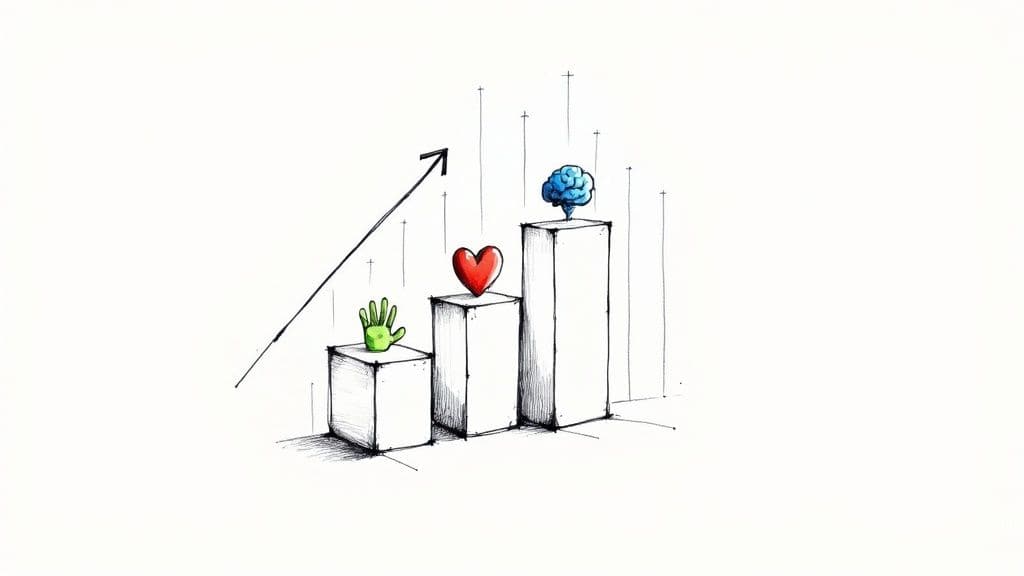How to Stay Focused in a Distracted World
Learn how to stay focused in a distracted world. Backed by science and real founder routines, this guide reveals systems, tools, and rituals to reclaim deep work and build momentum with SprintDojo.
Attention Is Your Superpower
In an age of endless scrolling, pings, and pop-ups, your attention is your rarest and most valuable asset. Solo founders, indie creators, and tech-savvy doers—especially those in their 20s and 30s—are navigating a world designed to distract. The cost of losing focus? Slower product launches, missed opportunities, creative burnout, and that nagging feeling of working all day yet finishing nothing.
Consider this: a recent study by Dr. Gloria Mark found that people working on screens switch tasks every 47 seconds on average. [source] In a world optimized for engagement, not productivity, holding your attention has become a revolutionary act.
Focus isn’t just a personality trait. It’s a skill—and one you can train.
This essay explores how to do just that. Backed by neuroscience, psychology, and real-world habits from high-performing founders, we’ll dive deep into how your brain handles attention, how the digital world is hijacking it, and how to build your own focus system. Along the way, we’ll also introduce SprintDojo, a platform designed to help solo builders stay focused and accountable through weekly sprint cycles.
Whether you’re coding a side project, writing a book, or launching a new venture, this guide will help you:
- Understand why it’s hard to focus (it’s not just you)
- Learn practical, science-backed tools to reclaim your attention
- Build rituals, environments, and systems that protect deep work
- Leverage technology (like SprintDojo) to build momentum and finish what matters
Let’s start with what’s happening inside your brain when you try to focus.
⸻
The Science of Focus
⸻
1.1 How Your Brain Handles Attention
At its core, staying focused is a tug-of-war between competing systems in your brain:
- The prefrontal cortex (PFC): your brain’s “CEO,” in charge of goal-setting, planning, and attention control.
- The default mode network (DMN): your brain’s background chatter machine—daydreaming, future-planning, random thoughts.
When you try to concentrate, your PFC is doing the heavy lifting. It filters out distractions and keeps your goal top of mind. But it’s fighting against:
- Bottom-up attention: triggered by external stimuli (notifications, sounds, sudden movement)
- Attention residue: the lingering focus from previous tasks that disrupts new ones (→ see Sophie Leroy’s research: Attention Residue)
Each time you switch tasks, your brain doesn’t fully reset. It leaves residue that impairs performance on the next task. This is why multitasking is a myth when it comes to cognitive work.
⸻
1.2 Why We Struggle: Dopamine, Distraction & Fatigue
Your brain’s reward system runs on dopamine, a chemical that spikes when encountering something new or pleasurable, like scrolling Instagram or checking Slack.
Apps know this. They serve content designed to hijack your attention.
📊 Fun Fact: Heavy social media users, in brain scans, show patterns similar to people with ADHD. → Source: ScienceDaily
Other issues that sabotage focus:
- Working memory is limited—distractions fill it quickly
- Digital multitasking exhausts the brain faster than monotasking
- Sleep debt, poor nutrition, and lack of movement reduce your cognitive control
And here’s a kicker: simply having your phone in the same room, even turned off, reduces your working memory capacity. → Source: Journal of the Association for Consumer Research ⸻
2. Digital Distractions Are Designed to Win
If you feel like you’re constantly distracted, it’s not your fault — it’s by design. Today’s digital tools and platforms are engineered to hijack your attention and keep you engaged for as long as possible.
⸻
2.1 Social Media’s Business Model: Hijacking Your Brain
Social media platforms use the same variable reward systems found in slot machines — unpredictable likes, notifications, new posts. This randomness keeps your brain hooked and craving more.
🧠 Tristan Harris, a former Google design ethicist and co-founder of the Center for Humane Technology, explains that these platforms create dopamine-driven feedback loops. → Source: Humane Technology
📉 Frequent digital media use has been linked to attention problems, especially in younger users. → Study from JAMA
⸻
2.2 Notifications and the Multitasking Myth
Every ping, badge icon, or notification is a distraction grenade. Once interrupted, it takes you an average of 23 minutes to fully regain your original level of focus. → Source: Gloria Mark, UCI
And no — you can’t “just multitask.” In fact, multitasking makes you worse at filtering distractions and switching tasks. → Stanford Multitasking Research
Instead of doing more, we do worse: slower, sloppier, and more stressed.
⸻
2.3 Founders at Risk: Always Online, Always Available
As a solo founder or creator, your work lives online — Slack, Notion, Twitter, Figma, VS Code. It’s easy to get trapped in endless context switching, jumping between messages, meetings, and dashboards.
But context switching kills momentum.
That’s where SprintDojo comes in.
🧘♂️ It’s designed to protect your time, build in focus rituals, and cut through digital noise with structured sprint cycles. SprintDojo users:
- Plan weekly goals with intention
- Show up to short daily sprints
- Commit to one task at a time with visual accountability
It transforms chaos into clarity.
3. Evidence-Based Strategies to Reclaim Focus
Now that you understand the science and the enemy (distraction-by-design), let’s dive into strategies that actually work. These methods are proven by research and practiced by top performers.
⸻
3.1 Time-Blocking and the Pomodoro Technique
The Pomodoro Technique is simple: 25 minutes of focused work, followed by a 5-minute break. After 4 cycles, take a longer 15–30-minute break.
⏱️ Research shows it reduces mental fatigue and boosts sustained attention. → Source: Frontiers in Psychology
🗓️ Time-blocking—allocating chunks of time for deep work—is also powerful. It eliminates decision fatigue and helps protect your calendar from reactive tasks.
🛠️ SprintDojo helps you do this naturally through Sprints, which structure your day into high-intention focus blocks.
⸻
3.2 Deep Work and Focus Rituals
Cal Newport’s Deep Work highlights the value of long, uninterrupted time blocks for creating valuable output. Even just 2 hours of deep work per day can outperform 8 hours of scattered, distracted effort.
🏯 SprintDojo is built on this principle. It provides rituals that help you enter “sprint mode”, just like elite athletes warm up before competition.
⸻
3.3 Mindfulness and Meditation
Mindfulness reduces stress, improves attention, and boosts cognitive flexibility.
🧘 Just 10 minutes of meditation per day can increase your working memory and decrease mind-wandering. → Source: NIH/PMC study
💡 Tip: Add a 2-minute breathing ritual before starting each SprintDojo session to prime your brain for focus.
⸻
3.4 Optimize Your Environment
Your environment either supports your focus or sabotages it.
🧹 Clean desk, clean mind. Visual clutter increases cognitive load.
📱 Use tech like:
- Focusmate – coworking with real accountability partners
- Freedom or Cold Turkey – website blockers
- RescueTime – analytics on where your time really goes
🧭 SprintDojo’s minimalist dashboard keeps your focus tight. No fluff. Just sprints, reviews, and wins.
4. SprintDojo: Building a Focus Culture
4.1 What Is SprintDojo?
SprintDojo is a focus platform designed for solo founders, indie creators, and builders. It combines the best of productivity science with a clear weekly structure:
- Set a North Star: Define the outcome you're working toward
- Plan weekly: break that goal into actionable sprints
- Sprint daily: short, high-focus work sessions
- Reflect weekly: build momentum through review
⠀It’s like having a dojo for your attention—a place to train, reset, and get better every week.
4.2 Why It Works: Ritual, Identity, Momentum
SprintDojo isn’t about doing more—it’s about doing what matters. It helps you shift from:
- 🚫 Random effort → ✅ Focused intention
- 🚫 Reacting → ✅ Creating
- 🚫 Procrastination → ✅ Action
And it taps into something powerful: identity-based behavior.When you show up every day and complete your sprint, you reinforce a simple truth:
“I’m the kind of person who follows through.”
Weekly sprints help you stay aligned with your North Star, break the cycle of scattered productivity, and establish a rhythm of progress.
4.3 Use Case: Imagine Lisa
Lisa is a solo creator building a micro-SaaS while writing a newsletter. She's not a real user yet—but she represents the kind of person SprintDojo is built to help.
Without a system, her days might feel chaotic:
❌ Too many tabs open ❌ No clear priorities ❌ Always reacting, rarely shipping
With SprintDojo:
✅ Monday: define her weekly intention ✅ Weekdays: I done this. ✅ Sunday: review her progress and reset for the week
Our vision is simple: Help people like Lisa move from noise to clarity. From ambition to completion.
SprintDojo gives creators structure without friction, making it easier to do the work that matters most.
5. Tools That Support Your Focus System
Focus isn’t just...
Sprint Smarter. Forecast Every Week.
Log wins. Build momentum. Let AI show you if you're on track to hit your sprint goal—before it's too late.
Join the waitlist and be the first to unlock predictive clarity for your team.

